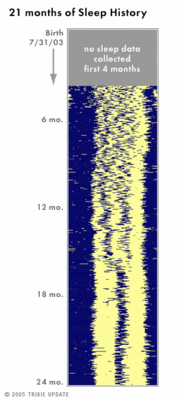Development of the human sleep patterns

Trixe Update is a blog that is very unusual. First, just looking technically, the posts go from top to bottom instead of the latest post being on the very top. Second, the whole blog is devoted to the day-by-day growth and development of Trixie, from birth until about the age of two.
The graph on the right (and there are many different graphs there) shows the sleep-wake cycle. Unfortunately, the first four months - the most interesting months - are missing (I hope they have another kid and do this again from Day 1). But even without the missing data, you can see how the sleep rhythm gradually becomes more and more coherent. At the age of two, Trixie has a clear bimodal pattern of sleep: a long bout throughout the night and a shorter bout around mid-day.
Notice the 16-months time point. Until that time, Trixie was sleeping TWO naps per day in addition to a nicely consolidated night sleep.
Now, look at the first ten months or so. Trixie is sleeping much more during the night than during the day, but there are so many daytime naps and so many awakenings at night, that the actograph appears very messy.
If the data for the first four months were available, you could see the complete absence of a daily rhythm of sleep. The whole 24-hour period looks like the daytime period at 4-10 months of age.
Take a closer look at that 4-10 months period. Look at the onsets and offsets of sleep episodes. It appears as if there are several clocks, each with a different period (some shorter some longer than 24 hours), each trying to drive a separate rhythm of sleep and wakefulness. This is even more apparent in newborns during the first six weeks of life.
The notion here is that various multiple circadian oscillators within the human suprachiasmatic nucleus (SCN) are still, at this age, not coupled to each other, and that it may take as long as several months postnatally for the pacemaker to produce a single unified circadian output.
Exposure of the infant to a light-dark cycle (full daylight during the day and pitch darkness during the night) may speed up the development of the consolidated pattern.
Mother's exposure to a light-dark cycle will also entrain her circadian clock. This, in turn, will entrain her rhythm of nocturnal secretion of melatonin. It has recently been found that mother's milk contains melatonin. It is well established in other mammals (not yet in humans, though) that daily exposure to melatonin entrains and consolidates circadian rhythms in the fetal and neonatal offspring.
Thus, both mother's and infant's exposure to a robust light-dark cycle are likely to aid in quicker consolidation of the baby's sleep-wake cycle - something that is a major goal of all parents!






4 Comments:
Looks like it is smoothing out?!
R2000
cute little box has been posting this comment everywhere...strange...
chazinc.blogspot.com
Getting some spam recently, Coturnix?
Great post, very informative as usual, and a great find!
The only thing I would add, after three kids, is that it never stabilizes as fast as the parents want!
Post a Comment
<< Home